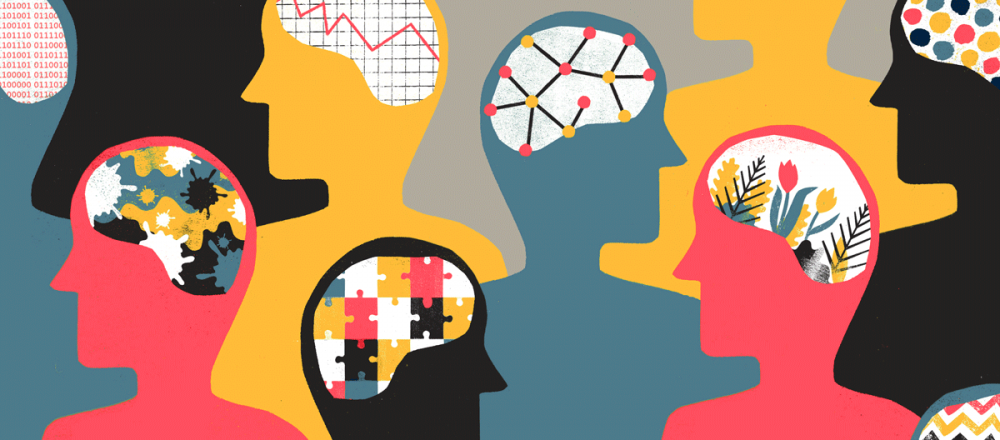I sat at a COVID-safe Melbourne Exhibition Centre with multiple speakers – the Premier, the Chair, the Minister for Mental Health – as the Royal Commission’s final report into Victoria’s mental health system was tabled, there was one message that sung through: “the system is broken.”
But the statement, “the system is broken,” conceals far more than it illuminates. Like “we’re all in this together,” “Team Australia,” or “Harmony Day,” it is just rhetoric.
In reality, there is disagreement and tension at the heart of the mental health Royal Commission’s reform process.
Much of this centres on the representation of consumers – a term commonly used by/for people who use mental health services – in the Royal Commission and the focus (or lack of focus) on human rights.
The Royal Commission found that the system has catastrophically failed people with lived experience.
Some people go seeking support but find there is none there. Others experience stigma within the community and the system. Families, supporters, and carers have reported that they are left without support of any kind.
Chair of the Commission, Penny Armytage AM at the launch stated the importance of human rights.
“Consumers still have their human rights breached through compulsory treatment and the use of seclusion and restrain,” Armytage said.
This statement is an important admission, as it highlights that both compulsory treatment and the use of seclusion and restraint are a breach of human rights.
What has the Royal Commission recommended?
The Royal Commission has recommended a suite of changes that impact human rights.
- The new Mental Health and Wellbeing Commission (recommendation 44) will hold complaints and investigation functions currently held by the Mental Health Complaints Commissioner and new ‘own-motion’ inquiry functions to investigate matters of concern.
- Ending seclusion and restraint within ten years (recommendation 54), reducing compulsory mental health treatment (recommendation 55), and introducing a new Mental Health and Wellbeing Act (recommendation 42) all reflect steps towards a more human rights-compliant mental health system.
- Commissioning (funding) of services will require, at first instance, demonstrated capacity to adhere to the Charter of Human Rights and Responsibilities Act 2006 (Vic) (recommendation 51; section 28.4.1), which will require a significant overhaul of service design features, as services have demonstrated to poor practice across the board.
- The reinvestment in the community and community services (including rec 15; rec 20.1.a; recommendation 26.1.d; recommendation 33), trauma-focused services and research (recommendation 23), and consumer-led safe spaces (recommendation 9) all enable voluntary and less restrictive forms of care that will hopefully prevent consumers being locked within the clinical mental health system.
- There are, therefore, reasons to be optimistic. However, significant questions remain about the Royal Commission’s direction and the steps that we should take, led by consumers, from here.
Did we get the system’s diagnosis correct?
The report and communications surrounding it focus on how systems planning and under-investment have meant people could not get the support they needed; when they needed it.
But this is not a full or correct diagnosis.
In 2020, I coordinated a project that supported 34 people in giving evidence to the Royal Commission.
The most common issue raised the imbalance of “power and control.”
Consumers of mental health services have diverse, enduring, episodic, and often traumatic experiences from the mental health system.
This emerges, not just from a lack of funding but from an oversupply of biomedical bureaucracy that has othered and subjugated consumers.
We can see this in early psychiatric diagnoses that policed the “normal” from the “abnormal.” Being gay (ego-dystonic homosexuality), being a woman (hysteria), being trans (gender identity disorder), or escaping your slave owner (drapetomania), wouldn’t strike you now as pathologies of our collective spirit rather than any individual mind. And yet, these were boundaries policed by mental health systems. When we look at classifications such as borderline personality disorder (a deeply gendered diagnosis) or oppositional defiance disorder (just an absurd diagnosis), biomedicine’s controlling function should remain the front of mind.
Treatments have been equally concerning. Writing about the contemporary moral and empirical issues with using electro-convulsive therapy, Dr John Read wrote in Aeon magazine that the treatment risks continuing a tradition of failing those that receive care:
“Electroconvulsive therapy joins a long tradition of applying extreme physical procedures to distressed or distressing people: harsh laxatives, bloodletting, blistering of the forehead, rotating chairs, surprise baths, being packed in ice, inoculation of scabies, force-feeding chimney soot and woodlice and, briefly at the beginning of the 20th century in the US, surgically removing teeth, testicles, ovaries, gall bladders and colons.
The 20th century witnessed malaria-induced fevers, insulin-induced comas and a range of ‘psychosurgery’ procedures including hammering an ice-pick-shaped instrument into the brain via the eye socket and insertion of radioactive yttrium into the brain.”
While some of these treatments were rogue during their time, many were considered contemporary evidence-based practice.
These examples speak to a domain of healthcare where the greatest political and coercive powers are granted to an area of science that has consistently had the least evidence.
It will be hard for the mental health consumer community to reconcile that this Royal Commission represents a new path when leaders from that community were excluded from decision-making within the Commission; instead, they were forced to watch from the sidelines.
In the report consumer leader, Cath Roper, reminds us that power, ideology, and history have been marginalised from the conversation.
“We need approaches in which we deliberately and proactively try to understand issues around power. We need to think consciously about whose voice might be the thinnest or the hardest to hear,” Roper said.
If this does represent a new path, we must first stop and acknowledge the problem that has led us to the current system: power, over the powerless.
What is the role of consumer leadership, co-design, and co-production?
The State and Federal Governments have an obligation under articles 4.3 and 33 of the Convention on the Rights of Persons with Disabilities (‘CRPD’) to ensure that consumers are part of all decision-making processes that affect them.
In mental health, people often term this “consumer leadership,” which though undefined, can be broadly understood as people with lived experience of mental health issues and using mental health services being placed in leadership positions.
Co-design and co-production, broadly speaking, refer to consumers being equal decision-making partners across planning, designing, delivering and evaluating services and systems that affect them.
However, the Commission has heard that consumers have routinely been excluded from decision-making processes, both in their treatment and in the design, delivery, and evaluation of the systems and governmental decisions that affect them (Ch 18).
This Royal Commission advanced without a Consumer Commissioner, despite having Commissioners from carer, legal, public administration, and psychiatric backgrounds. Moreover, it remains unclear whether any consumer was employed in a decision-making role across the Commission’s leadership team. Such a slow-moving and conscious failure cannot be ignored.
Nevertheless, recommendations for substantive positions in the Mental Health and Wellbeing Division (rec 45.4), consumer-led safe spaces (rec 9), and the expansion of lived experience workforce roles (Ch 33) are all welcome.
It remains unclear, however, what the role of consumers is in the implementation of the recommendations. Within the whole report, co-design is referred to 9 times and co-production just 5 times in each of the 68 recommendations.
While this could be read as delimiting the role of the collaborative partnerships, these broader human rights obligations should ensure that such methodologies are taken to the implementation of all recommendations.
Suppose the Victorian Government is committed to set a new path. In that case, it will be crucial to prioritise early employment of consumers in an open and transparent process to prevent critical early implementation decisions from occurring without consumer oversight.
This will measure the Victorian Government’s commitment to a new path that shares power with consumers.
Are we committed to the progressive realisation of mental health laws that uphold, rather than undermine, human rights?
Mental health laws are full of contradictions. On the one hand, they are spoken about as providing rights, such as access to healthcare and safeguards against harmful treatment. On the other hand, their primary function has been to enable harm through compulsory treatment, seclusion, and restraint.
There are competing views on the lawfulness of force in mental health settings. Under original instruments such as the International Covenant on Civil and Political Rights, it was generally understood that compulsory treatment was permitted if subjected to various safeguards. However, with the emergence of the CRPD came explicit references to equal legal capacity, rights around physical and mental integrity, and the right to health without discrimination based on disability.
While some have argued that there are continued grounds for compulsory mental health interventions, there is clear guidance from the CRPD Committee. An emerging consensus is that it is no longer considered compatible with human rights.
The current Mental Health Act 2014 (Vic) (“MHA”) runs contrary to these obligations. The recommendation for a new Mental Health and Wellbeing Act to be introduced by the middle of 2022, may soften but not resolve this inherent contradiction.
With the extensive commentary and recognition of the harm caused by compulsory mental health treatment, a New Mental Health and Wellbeing Act should instead focus its attention on eliminating compulsory treatment by gearing the system’s new levers and renewed funding to focus towards elimination within five years.
If we are serious about a new path, these steps are necessary.
How will we oversee services to ensure protections become a reality?
Regulatory oversight isn’t a headline-grabbing topic or a dinner table conversation, but it does protect human rights.
In Victoria, the regulatory oversight system is intended to give effect to the limited protections available to consumers in the mental health system. Think of them as agreed to “guard rails” that ensure the mental health system operates as our Parliament and our community intended when creating laws. Or for consumers, they are the last line of defence in protecting their rights. The oversight system does this by granting the Office of the Chief Psychiatrist (“OCP”) and the Mental Health Complaints Commissioner (“MHCC”) broad powers to handle complaints, investigate, report and intervene in mental health service delivery.
These powers were part of the original MHA in 2014. Despite the introduction of the legislation and the presence of these agencies, there has been a continuous stream of human rights violations occurring within closed mental health environments.
Many of these were reported directly to the MHCC, highlighting either past failures to respect their human rights, or were part of desperate telephone calls to regulatory oversight agencies, as consumers warned of impending forced treatment; forced treatment that regularly failed to follow mental health and human rights laws.
Despite this, there are no known public interventions by the OCP to protect the human rights of consumers. Privately, consumers report that the office does little to help them. Publicly, the Victorian Auditor General’s Office in 2019 found that the OCP misleadingly stated (sec 3.7) that it had addressed prior recommendations for improvement as part of a 2016 review. The Royal Commission has recommended another review.
Despite the overwhelming evidence of non-compliance with the MHA, including daily calls to the office reporting an impending incidence of human rights abuses, the MHCC has never issued a single compliance notice (a mechanism to enforce mental health laws, s 260 MHA).
In the six years of operation (data available from July 2014 to June 2019, attachments LCB3-5), with 119 complaints about a staff-to-consumer assault, and 1208 complaints about a failure to uphold supported decision-making obligations, with year-on-year increases in overall complaints of the same themes, the MHCC has not used its powers. It hasn’t even released service-level data (overall summaries of the types of issues in each mental health service), despite persistent requests to do so and already choosing to provide this privately to mental health services.
These points are raised because it has been largely avoided in the Royal Commission’s report. In the quality and safety chapter (ch 30) it has focused on “coordination” between regulators as the key issue, rather than the more obvious diagnosis: regulatory failure and regulatory capture.
Regulatory capture occurs when regulators become “captured” by the industry they are seeking to regulate.
Regulatory failure is more easily understood as the failure of regulatory bodies, agencies, or processes to meet their stated objectives. A brief examination of these functions and goals – the protection and promotion of human rights, as well as continuous improvement – makes clear that this failure is systemic.
What this has resulted in are different legal worlds. In one world, the mental health profession is empowered to utilise mental health laws to provide compulsory treatment and ensure compliance with that law through force. In the other world, consumers attempt to exercise their rights, but lacking institutional force, locked behind closed environments, the consumers are failed and abused on mass.
The Royal Commission’s commentary largely avoids this in the chapters where it matters. Recommendations largely focus on coordination, placing complaints functions under the new Mental Health and Wellbeing Commission, and providing a new inquiries power. It is not clear, however, why this power would lead to radical change, when the previous powers had not been used.
But there are still opportunities to address this. Employing human rights and consumer experts in these organisations’ leadership teams will renew faith in the regulatory system. And the purpose must be clarified: beyond just “holding government to account”, the Mental Health and Wellbeing Commission must ensure the services who are granted coercive powers are equally held to account.
These steps are crucial to rise above the current inhumane system.
What role will the Human Rights Charter really play in addressing the mental health system
The Charter of Human Rights and Responsibilities Act 2006 (Vic) (“Charter”) has been in operation for 15 years now, but few mental health clinicians would have an understanding of it.
What even fewer community members know is that the Charter creates obligations on all parts of government and public administration, in ensuring that decisions which affect human rights are lawful.
Despite having an explicit place within the terms of reference, the place of the Charter in the mental health system remains peripheral in the Royal Commission’s recommendations.
Questions remain as to what extent the Charter will play in funding and systems planning, particularly during the early stages of reform before the new MHA.
For example, Mental Health Reform Victoria (“MHRV”) has begun rolling out 170 new beds in mental health services. There is a question, however, to what extent MHRV will ensure that new mental health beds are ‘Charter compliant,’ when the existing mental health system isn’t.
We must have human rights impact assessments (processes to see how the new beds will engage and potentially limit human rights) and local action plans to address the human rights shortcomings. Decisions about this will give an early indication about whether the Royal Commission implementation body is intent on upholding, or undermining human rights.
There are of course positive signs, such as the minimum requirement for services to be Charter compliant if they are to be funded. I for the life of me can’t understand how they will prove this on current performance, but I think these are the kinds of challenges our Royal Commission implementers should embrace if we are intent on a new path.
Where are we on human rights in the mental health system
There have been important findings and work from the Royal Commission, which have significant implications for human rights.
While there has not been radical change, there is opportunity to move in that direction. But there is also a risk for the current human rights problems to solidify, or get worse.
Early decisions by the Victorian government on appointments, inclusion of consumers and action on abuses will be instructive. Consumers inside and outside locked wards will watch with bated breath.



